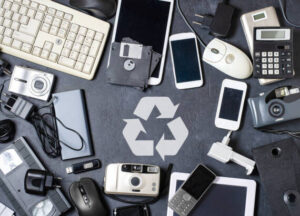Keeping gadgets alive is more than just a wish in a world when they captivate us like a siren song.
Not only will your tech remain in better working order by a little TLC, but you also give Mother Earth a friendly nod.
Although a mere 17.4% of our shockingly 53.6 million tons of e-waste went into a recycling bin. That would be like inviting just a few people to a party.
Still, fear not! One easy way to keep those gadgets of yours running like new is to do your share to help to reduce the shockingly high number.
Consider it as giving your devices a long, happy life with smart charging techniques, frequent dusting, and timely software spruces.
Keep your laptop away from dust bunnies, for instance, and you might stretch its life by up to 50%. Let’s get right to rolling things out together. This lighthearted list will help you:
- Give your devices some love; turn them off, grab a microfiber cloth, and, for the keyboards, blast compressed air like a wild west gunfighter. Dust vanish!
- Remain on the update train; set those software updates to cruise on autopilot and use your own reminder systems—like a reliable alarm clock but much more elegant.
- Treat that battery right: It has life to live; do not let it sleep over night. Store it in comfortable temperatures and keep it floating between 20 and 80 percent charged. Think of Goldilocks as not too hot or too cold.
Adopting these routines not only saves you a nice dollar.
It helps you to be a part of a great group striving for better use of technology and a better environment.
Together, we can transform basic maintenance into a powerful movement whereby technology serves us and expresses some love for our beloved earth as well.
Knowing gadget lifespan

In an environment where technological innovation rules, gadget lifetime is quite important. You purchase a gadget hoping it will last.
Still, many discover their cherished devices made useless long before their time.
Knowing the typical lifetime of ordinary appliances helps one to maximize their efficiency and durability.
Environmental conditions, maintenance degrees, and use patterns all affect device performance.
Understanding these aspects enables one to create a plan to extend the lifetime of devices.
Devices’ average lifespan ranges greatly.
For example, whereas laptops can last up to five to seven years with proper care, cellphones usually last two to three years. Generally speaking, tablets land in between. Avverages, however, can mislead.
Your treatment of your devices determines your personal experience.
Starting smart habits from now on can have a big impact.
These behaviors then support not only personal savings but also more general environmental initiatives.
Typical Lifespan of Common Tools
Knowing how long devices last helps one to understand the need of maintenance.
Many often used devices have an average lifespan of:
| Device | Average Lifespan |
|---|---|
| Smartphone | 2 – 3 years |
| Laptop | 4 – 6 years |
| Tablet | 3 – 5 years |
| Smartwatch | 2 – 3 years |
| Desktop Computer | 5 – 8 years |
| Television | 7 – 10 years |
| Game Console | 5 – 7 years |
These numbers differ depending on several elements, including frequency of use, the kind of applications or programs run, and surroundings.
A laptop kept in a dry, dust-free environment with regular cleaning, for instance, will last far longer than one subjected to spills or extreme temperature.
Factors influencing lifespan
A gadget’s lifetime depends on several factors. The most important are these:
- Quality of Build: Higher-end devices usually feature better materials and construction, so improving durability.
- Usage Type: Regular heavy use can cause wear and tear.
- Environmental Conditions: Environmental conditions including humidity, high temperatures, and dust can all over time negatively impact gadget performance.
- Maintenance Practices: Regular maintenance can cover updates, software management, and cleaning schedules meant to maintain devices in best performance.
Considering these elements will help consumers decide on maintenance as well as purchase.
Frequent device health check-ins help to prevent more major problems down the road and promote longer lifespans and general better performance.
Why Conservation Counts in Technology
Growing importance of sustainability as technology develops is evident.
More than ever, the idea of sustainable technology entails realizing how disposed of devices affect the surroundings.
E-waste is a major problem since incorrect disposal of it can damage our earth.
Longer lifetime of devices helps people support sustainability by lowering waste and encouraging resource economy.
Over time, sustainable maintenance methods help consumers save money while also encouraging better habits.
According to a Global E-waste Monitor estimate, 53.6 million metric tons of e-waste will be produced worldwide just in 2020. Only 17.4% of them, though, were properly recycled.
Maintaining devices for longer stretches of time falls on consumers as much as manufacturers.
Understanding and supporting techer sustainability helps users to adopt a mindset that supports longevity, durability, and ecological consciousness.
Consistent Maintenance Techniques
Maintaining appropriate device performance calls for discipline and consistency.
Frequent maintenance helps your devices last much longer and guarantees their optimal performance over that period.
Though every gadget has different requirements, some basic maintenance techniques appeal to many kinds of devices.
Regular cleaning of your devices helps to remove grime, dirt, and dust accumulated over time.
Ignoring your devices will only cause problems, much as you wouldn’t ignore the laundry mounting up.
Make sure you use particular cleaning techniques fit for the gadget to enhance general appearance and performance.
Proper Cleaning of Your Devices
Although every device requires different cleaning techniques, these are some sensible guidelines to apply:
- Tables and Smartphones:
- Cut off the gadget’s power.
- Work on the screen with a microfiber cloth.
- For cracks, either compressed air or a soft-bristled brush will help.
- Regarding laptops:
- Clean the keyboard often using the same microfiber cloth.
- Dust from vents and fans can be dislodged with a compressed air can.
- To prevent streaks, wipe the screen with suitable cleaner.
- Desk Computers:
- Before scrubbing, disconnect peripherals and power.
- With a moist cloth, clean the outside.
- To properly clean internal components, remove the case.
Following a cleaning schedule will help keep devices looking brand-new and running.
Apart from looks, a neat device reduces overheating and other performance problems.
Software and Firmware Updates
Maintaining devices depends on regular updating of firmware and software.
Usually including security patches, bug repairs, and improvements, these updates help devices to run as they should. Here’s how to handle this:
- Enable Automatic Updates: Most devices let users set whether or not to have automatic updates. This function guarantees that important updates occur free from user control.
- Regular Checks: Global studies indicate that, given hectic schedules, almost 60% of users overlook to install updates right away. If not automated, set a monthly reminder to personally seek for updates.
- Backup Your Data: Always do required backups before doing major changes to your data. This habit protects critical files and data against unanticipated problems.
Keeping current software not only increases general user experience and security but also extends hardware lifetime.
Older software-running devices may have performance issues or even vulnerabilities hackers could find use for.
Management and Maintenance of Batteries
Many times, batteries shorten the lifetime of devices. One must understand how to look after them.
These pointers help you efficiently control battery life:
- Avoid Extreme Temperatures: Keeping devices in too hot or cold surroundings might reduce their battery life.
- Charge Smartly: avoid running overnight charges on all of your devices. Extended periods of keeping them charged to 100% can result in “battery memory,” which accelerates device drain.
- Use Battery Saver Modes Engaging battery saver features can maximize power use, so extending charging cycles and general battery life.
Battery life depends in great part on user behavior. Common in modern devices, lithium-ion batteries—which Battery University claims last longer when kept partially charged—are found in Recharging is best when the battery falls to about 20%; unplug when it reaches roughly 80%.
Conscious Consumption Practices
Extending the lifetime of devices depends mostly on smart usage habits.
These continuous activities create conditions where devices can flourish without sacrificing performance.
Optimal gadget lifetime can result from several habits.
One still depends much on discipline.
Little changes in your use of technology will pay off over time.
From cleaning digital environments to lowering overheating risks, every action helps to prolong equipment.
Preventing Heat Exposure and Overcharging
For many consumers, overcharging offers a major obstacle.
Control of charging methods can help to extend the lifetime of devices. Here’s how to use smart charging:
- Set Charging Limits: Many phones have settings that tell you when your battery gets to particular levels. Remember this using this function.
- Use a Quality Charger: Use a Quality Charger: Underheating results from cheap chargers not providing the ideal output for your device.
- Mindful Charging Locations: Avoid charging devices in direct sunlight or on cloth surfaces. Degrade of battery performance can result from overheating.
Emphasizing the need of avoiding overheating conditions, data indicates that heat might shorten battery lifetime by up to 20%. Maintaining cooler surroundings for devices guarantees better performance and over time helps to preserve battery life.
Developing a Digital Decluttering Routine
Keeping devices clutter-free improves performance as much as appearance.
These techniques are some ways to do efficient digital decluttering:
- Regularly Remove Unused Apps: Studies reveal that almost forty percent of the installed apps go unused on a regular basis. Maintaining just what you really need will improve performance.
- Organize Files: Create folders and file categories. This method reduces stress and facilitates later faster searches.
- Schedule Regular Cleanups Plan frequent clean-ups of your digital environment for one hour each month. Consistency will increase output and help to clear clutter.
Including decluttering into your daily schedule helps you to keep better functioning.
A well-organized tool can operate more effectively, so extending its lifetime.
Leveraging Protection Like Cases and Screen Guards
Buying protective gear helps devices stay free from physical damage.
Protective cases and screen guards create barriers against drops, scrapes, and other possible problems related to everyday use. They assist like this:
- Dampening Impact: Cases lessen some of the shock should a device be dropped.
- Preventing Scratches: Screen protectors lay a thin layer that stops coins or keys from causing scratches.
Selecting appropriate defense is crucial. While some choose ultra-thin cases that cause little bulge, heavier-duty models provide better defense. Studies suggest that a protective case can cut accidental damage by sixty percent.
Fixing Rather Than Replacing

One interesting way to keep devices and promote sustainable practices is to repair them instead of right replacements.
You can help to extend gadget life by knowing when to repair, what typical problems can be fixed, and how to negotiate repair services.
Many times, parts on devices allow one to replace or fix them for a fraction of the cost of buying a new gadget.
Making sure you have relevant knowledge about repair choices helps you to develop a creative attitude that reduces waste.
When to Repair Your Device
Crucially, one knows when to repair rather than replace.
These indicators point to a repair as maybe the better choice:
- Minor Physical Damage: Often times, a cracked screen or dented casing can be fixed without having to replace the whole gadget.
- Battery Performance Issues: If battery life has dropped noticeably, a battery replacement will bring back functioning.
- Software Problems: Usually rather than replacing the device itself, updates, resets, or software repairs help to fix glitches or sluggishness.
Studies show that almost half of consumers replace their devices out of minor problems without really need. Changing your perspective from repair to replacement not only helps to save money but also encourages environmentally friendly behavior.
Handy Advice for Typical Problems
Having basic repair knowledge enables you to handle typical problems on your own without consulting a professional.
These do-it-yourself ideas address typical gadget issues:
- Replacement Screens: Devices with cracked screens can find detailed instructions on screen replacements available online. Websites like iFixit consult pertinent tools and offer thorough directions.
- Battery Replacement: Many cellphones have user-replaceable batteries. Get a new battery and carefully swap it out using instructional videos.
- Cleaning Internals: Dust accumulation can compromise desktops’ or laptops’ performance. To clean the vents and fan, use compressed air under correct direction.
Learning these repair techniques not only helps to save money but also empowers one.
The ability to solve issues improves general gadget happiness.
Locating Expert Repair Solutions
Finding a professional repair technician becomes absolutely necessary when do-it-yourself choices are inadequate. Here’s how to find dependable fixers:
- Online Reviews: Websites like Yelp or Google Reviews can point up respectable neighborhood repair stores.
- Warranties: Check whether your device is still under warranty or if your insurance covers repairs, which could help to save rather large expenses.
- Manufacturer- Authorized Stores: Maintaining contact with approved service centers guarantees that the repair quality standards remain high should the device still be under manufacturer terms.
Researching repair choices takes time, but it results in improved service and maybe reduced costs.
Repairing rather than replacing will help to prevent early gadget retirement and fit environmentally friendly living.
Appropriate Disposal and Recycling
When it comes time to say goodbye to outdated devices, careful disposal and recycling choices are absolutely critical.
Knowing how to properly dispose of equipment promotes sustainable living and helps to avoid environmental damage.
Clear guidelines for responsible recycling can help to reduce the e-waste epidemic.
Millions of devices are reaching the end of their lifetime yearly, thus careful handling what remains is crucial.
Many companies encourage recycling initiatives to help to create a better earth.
How to Conscientiously Get Rid of Old Devices
Getting rid of devices doesn’t have to cause problems. The following describes proper disposal:
- Data Wiping: Make sure every piece of data on the device is totally erased before disposal. Use appropriate erasure tools in suitable software programs.
- Check Local Recycling Policies: Many cities have specialized e-waste collecting programs. Learning about local policies guarantees your compliance with rules.
- Donating Old Devices: If a gadget is still in use, think about donating it. To help local charities, schools, or shelters to further extend gadget life, donations are usually welcomed.
You reduce the effect of e-waste by organizing a green disposal method.
Showing environmental care while letting go of tools promotes group accountability.
Trade-in options and recycling programs
Nowadays, many stores and manufacturers provide recycling programs so that customers may trade used goods for discounts on new ones.
Many times, these initiatives guarantee environmentally friendly behavior and proper disposal. Here are a few choices to give thought:
- Best Buy’s Recycling Program: The Recycling Program of Best Buy guarantees correct recycling while providing gift cards for trading in used electronics.
- Apple Trade In: Apple grants store credit for trading in older models. They rework materials and recycle goods sensibly.
- Samsung Recycling: To help offset the expense of new purchases, Samsung also runs a trading in used gadget program.
Through time spent in these initiatives, consumers help with the larger endeavor to cut e-waste.
Helping such projects promotes a more ecologically friendly future.
E-waste: Environmental Effects
E-waste keeps damaging our surroundings in shockingly different ways. According to the Global E-Waste Monitor, 53.6 million tonnes of e-waste will be produced worldwide by 2020. As technology develops and gets ever more ingrained in daily life, this number is expected to keep rising. Lead and mercury among other harmful elements found in e-waste can contaminate soil and water supplies, so causing great health hazards.
Taking responsible actions counts in order to offset the negative consequences of e-waste.
Customers have to learn about the lifetime of their devices to reduce their contributions to the developing e-waste problem.
People can help directly to reduce environmental impact by thinking through recycling choices and regular repairs.
Selecting Eco-friendly Devices

Choosing sustainable devices becomes more important as technology develops for consumers trying to lower their environmental impact.
Consumers want environmentally friendly products with defined traits that support longevity, durability, and responsible sourcing; sustainability has become just a buzzword.
Selecting sustainable technologies goes beyond only considering cost considerations.
Now the focus moves to knowing a gadget’s whole lifetime.
Knowing which brands give sustainability top priority guides the choice of a device.
Companies Dedicated to Sustainable Development
Reflecting the increasing demand for environmentally friendly technology, several brands have started implementing sustainable practices. These are some noteworthy ones you should give thought:
- Apple: Renowned for its manufacturing techniques’ dedication to using recycled goods and renewable energy.
- Dell: Has projects meant to cut e-waste, provide take-back programs for obsolete equipment, and include recycled plastics into new goods.
- With its products, HP encourages a circular economy and aggressively looks at using more sustainable materials.
- Pioneers in ethical consumer electronics, Fairphone gives recyclable materials top priority along with fair labor policies.
Before a purchase, consumers should investigate brand values and product certifications.
Selecting companies that actively adopt sustainable practices guarantees a change towards a planet in better health.
Green Devices You Should Think About
Several devices made in line with the sustainable push consider the surroundings:
- Perfect for lowering reliance on electricity and pushing alternative energy sources are solar-powered chargers.
- Many companies today create computer sleeves or phone covers out of recycled materials.
- Energy Star rated appliances and electronics will help you to guarantee energy efficiency and reduced running costs.
- Fairphone and other companies create modular devices that let users replace parts instead of throwing away whole devices.
Consumers significantly help to lower electronic waste by concentrating on devices using environmentally friendly technology.
Investigating goods and paying attention to decisions helps one lead a more environmentally friendly life.
Value of Product Certifications
As environmentally friendly devices become more popular, product certifications give consumers knowledge on the sustainability criteria of a gadget. Among several required certifications are:
| Certification | Description |
|---|---|
| Energy Star | Identifies energy-efficient devices. |
| EPEAT | Rates products based on environmental impact. |
| RoHS | Restricts hazardous substances in manufacturing. |
| Fair Trade | Ensures ethical production practices. |
These certifications support ongoing sustainability and ethical manufacturing practices and direct consumers toward informed purchases.
Learning these markers helps one to practice sensible consumption.
Improvements and Modifications
Improvements and tweaks that not only improve performance but also prolong operating life for many gadgets.
Investigating these paths enables consumers to match a sustainable approach with customizing their technology to fit personal needs.
While minor performance issues call for replacing whole devices, strategic upgrades can revitalize current devices.
This not only saves money but also promotes a mindset fit for longevity and economy.
Improving Performance with Upgrades
Without always having a new gadget, upgrading parts of devices can result in better performance. Here are typical ways to improve performance:
- For desktops and laptops, adding more RAM will greatly increase speed and enable more fluid multitasking.
- Changing out conventional hard drives for SSDs speeds up boot times and increases general responsiveness.
- For improved security and features, think about updating your operating system or programs.
- Graphics Card Upgrades: Improving the graphics card will greatly increase gaming system performance, so extending the lifetime of the whole configuration.
At a fraction of the price, investing in upgrades can produce performances on par with those of new devices.
Many consumers find that their needs are met without having to pay for whole new devices.
Accessorizing for Lifelong Use
Device lifetime can be much influenced by accessories’ investments.
Accessories improve use, offer protection, and let one customize them. Here is a closer view:
- Especially for laptops and desktops, keeping dust and trash off keyboards helps them last longer.
- Investing in a cooling pad for laptops helps stop overheating during demanding tasks.
- Good-quality chargers and cable management help ports from wear and tear remain free.
- For touchscreen devices, stylus pens are useful; they also help to extend functionality by lowering screen wear.
Although devices are usually made for durability, compatible accessories significantly help to extend their lifetime.
Such accessories show a user’s dedication to protect technology while fully using the gadget.
Using extensions and add-ons sensibly
Although they improve capability on many devices, extensions and add-ons should be used carefully. These ideas will help them to maximize their value:
- Before including possible add-ons into current systems, find out their authenticity and usefulness.
- Use extensions and add-ons following required criteria and guidelines to guarantee interoperability under federal oversight.
- Limit Excessive Additions: Steer clear of installing too many add-ons to cause performance to suffer. Rather, give solutions addressing particular needs top priority.
Users simplify processes and improve performance by concentrating on quality over quantity regarding extensions, so extending lifespan.
The Development of Eco-friendly Technology

As sustainable technology develops, gadget lifetime will depend much on innovation.
Knowing these patterns helps people to be excited about what is to come and enable them to participate actively in forming environmentally friendly technology.
Acknowledging the influence of consumer decisions guarantees responsibility in the IT sector.
Novelties in Product Longevity
Constant challenge to the status quo of gadget lifetime comes from new technological innovations. Among notable developments are:
- Companies like Fairphone are introducing modular designs that let consumers replace components rather than throwing away whole devices.
- Manufacturers are looking at biodegradable materials for building to help to lower future waste.
- 3D printing allows one to create replacement parts, so enabling the possibility for rather than replacement of different components repairs.
These developments support a cultural change.
Customers start to take awareness of their decisions and demand ethical behavior that helps the surroundings.
Consumers’ Part in Sustainable Technology
Users have great influence.
Companies are more likely to veer toward sustainable practices as support of them rises. Consumers can help to affect this change by:
- Support environmentally friendly companies by giving buying from those well-known for sustainability and ethical behavior top priority.
- Encouragement of supply chain transparency by businesses helps to foster practical responsibility.
- Share with others your knowledge of sustainable technology practices, so increasing general awareness in local communities.
Every purchase and discussion shapes the course of business methods.
Personal decisions come together to form a group movement influencing better tech environments for next generations.
Emerging Patterns in Green Technology
- Many wearables nowadays support active lifestyles and feature environmentally friendly materials.
- Integrated energy-efficient systems enable users of smart homes to properly control their energy usage.
- Remote working tools keep growing and help to lower commuting emissions by boosting production.
Adopting environmentally friendly habits confirms the conviction that sustainable technology is not only feasible but also indispensable.
Result
Ultimately, the path to prolong the life of your devices is not only a necessary step toward sustainability but also a means of personal maintenance.
With proper care and foresight, every gadget can serve beyond its expected lifetime.
As we have covered, regular cleaning, software updates, and conscious use of simple habits can significantly affect lifetime and performance.
Adopting these habits not only helps you save money but also helps to lower e-waste—a serious problem in our society dependent on electronics.
Actually, reducing personal waste by conserving gadget life will help to emphasize how small actions add up to more major environmental benefits.
Moreover, the focus on sustainable technologies makes deliberate consumerism absolutely necessary.
Selecting companies like Apple and Dell that give sustainability top priority not only supports moral behavior but also guarantees that your purchase fits the state of the earth.
As shown, the astonishing fact that just 17.4% of e-waste is recycled emphasizes how urgently sensible recycling and disposal practices are needed.
Programs aimed at recycling and appropriate disposal help us to fight e-waste and support a society that values the lifetime of our products.
Every decision we make—from choosing an upgrade over a replacement to wearing protective gear—helps to shape the developing story of sustainability as we negotiate the future of technology.
The developments in modular technology and the growing popularity of environmentally friendly product designs point to a bright future enabling consumers to be tech stewards.
When we give maintaining the devices we love top priority, the surroundings really improve and our daily contacts with technology have a more meaning.
Developing a sustainable tech lifestyle is ultimately about developing a lasting habit that stresses longevity and responsible use, not only about following the newest trends.
Let us also commit to a path of sustainable practices so that both our tools and the earth flourish together as we honor them and realize their part in our life.
Common Questions
Common devices usually have what average lifespan?
The typical lifetime varies.
Smartphones last two to three years; laptops can last four to six years; televisions last roughly seven to ten years.
Extending these lifetime depends much on proper maintenance.
How might I make my devices last longer?
Key is routine maintenance.
This covers maintaining battery life, cleaning tools, updating software, and smart use practices.
Every little bit helps your gadget last.
How should I clean my devices according to best standards?
Use a microfiber cloth and soft-bristled brush on tablets and cellphones.
Laptops need air and a light wipe-down to clear dust.
Before cleaning, always power off devices to prevent inadvertent damage.
Why does my device’s software updating matter?
Since updating software sometimes includes security patches and performance enhancements, it is absolutely vital.
Ignoring updates might cause vulnerabilities and slower performance, so reducing the lifetime of your device.
How should I treat the battery of my device?
Steer clear of extremes and don’t let batteries run constantly toward 100%. Recharging between 20 and 80% and running battery saver modes help to maximize battery life.
When my gadget starts to show little problems, what should I do?
Think about repairs instead of replacements.
Usually minor problems like a cracked screen or inadequate battery life can be resolved.
This strategy advances sustainability and helps to save money.
Are my devices fixable on my end?
Indeed, a lot of common repairs can be done on-demand by yourself! Resources like iFixit offer direction for battery swaps and screen replacements.
Learning these abilities empowers you as well as saves money.
How should I dispose of my used electronics?
Before disposal, wipe your devices; also, find out local recycling policies.
Giving working devices is another great way to help others by extending their lifetime.
Which tech brands prioritize sustainability?
Companies including Apple, Dell, and HP promise to cut e-waste by using recycled materials.
Selecting environmentally friendly solutions calls for thorough study of brand values.
How might consumers affect environmentally friendly technological solutions?
Support environmentally friendly companies, call for supply chain openness, and teach others sustainable practices.
Every deliberate decision adds to a better tech ecosystem.





